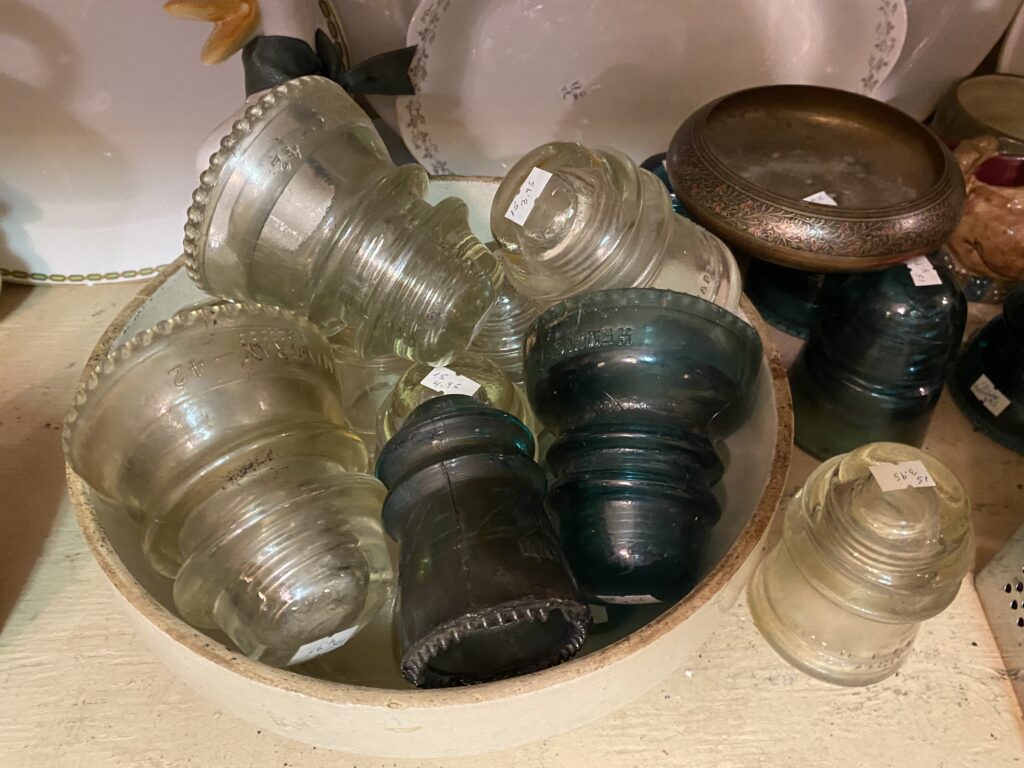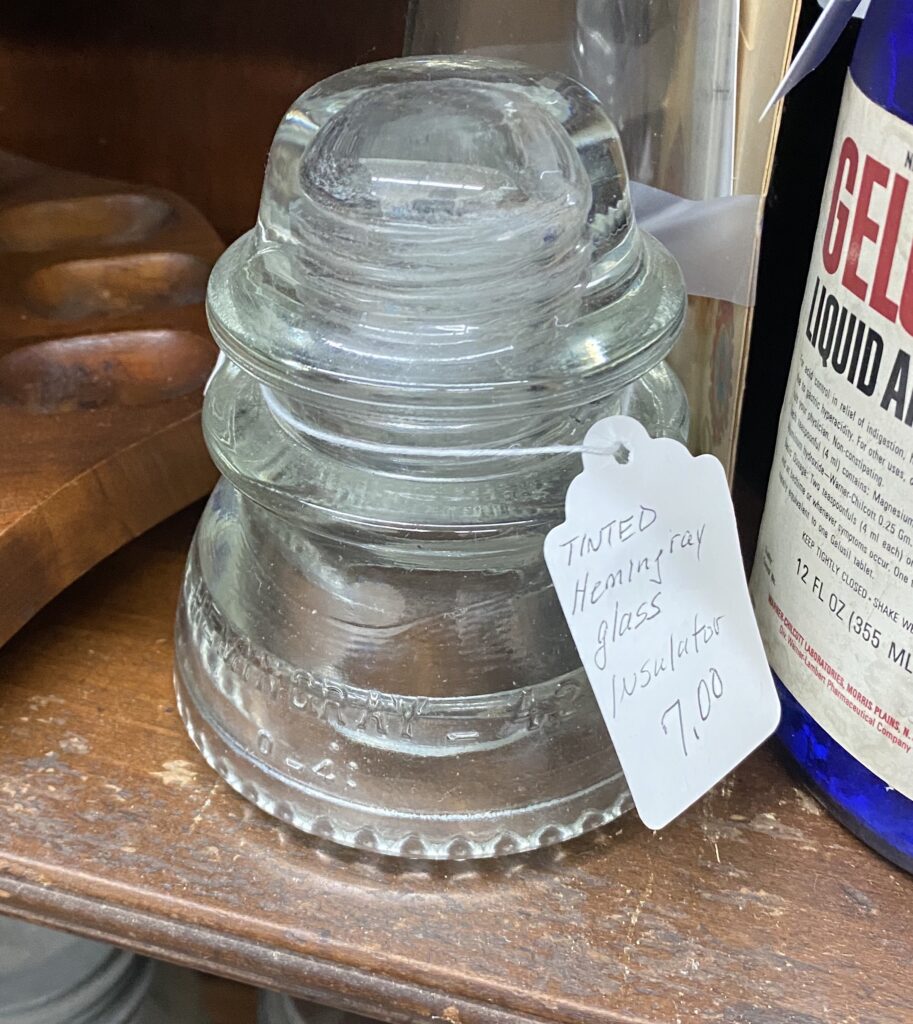Glass insulators were commonly manufactured for over a century—that’s a pretty wide range for a glass piece, luckily there are a number of ways to narrow the range a bit for any insulator added to a collection.
Vintage glass insulator identification can be accomplished through a few key physical analyses of a piece. The easiest is to look for any identifying embossing, which could communicate a range of information including the manufacturing or ordering company and the date of the casting mold, manufacturing, or patent. Construction style, glass type, and coloring can also be considered to date an insulator, although some of these require costly laboratory testing.
Thankfully, laboratories are rarely necessary. Read on for detail of how to garner information about the age of a vintage glass insulator.

How Can You Tell How Old a Glass Insulator Is?
There are a few different general categories that can give you an idea of an insulator’s age. The most obvious category is threadless vs. threaded securement pins. For about the first two decades of glass insulator manufacturing, different methods for securing the insulators to the poles abounded. Some were inset, others were secured with a tar substance around a wooden pin. But after Lee Covey created the threaded pin in 1865, that quickly became the industry standard.[1] So non-threaded can generally (but not always, there are exceptions) be dated to 1846-1865.[2]
That leaves the vast majority of insulators to account for. Thankfully, as multiple companies began producing more and more insulators through the 1870s, they started realizing it was murky to identify which insulators had been cast by which manufacturer. By the end of the 1870s, identifying embossing on each insulator was a new industry norm.
What do the Numbers Mean on Old Glass Insulators?
Numbers embossed on glass insulators vary between the make year and model number—or sometimes both. There was a profusion of different embossing around the turn of the century, reflective of the profusion of manufactures trying their hand at insulator production during this period. The range of embossing simplified as industry leaders, like Hemingray or Brookfield, took the majority share of contracts and other businesses either died out or found their niche in other areas.
Embossing frequently include the name or symbol of the manufacturer, as well as a model number. Sometimes the model number changes on an annual basis and other times a separate year is included. Other times, just to be really confusing, the date that is included is actually the patent date. [3] But ultimately, each company developed their own method. By now, most manufacturers’ methods are well-documented and more or less traceable.

Some examples: Hemingray had their own dot-based methodology whereas Brookfield, operating out of multiple locations, noted the pertinent shop number on each insulator’s crown. [4] Hemingray’s method allows for their insulators to be tracked to the exact year; Brookfield’s at least narrows down to a range of when the particular shop was functional.
Even within a single manufacturer, a variety of embossing styles may have been used. “A. T. & T. Co” is a known emboss—but it clarifies whom the insulator was made for, not whom actually made it. An ongoing mystery is the case of the five-pointed star. [5] Narrowed down to four companies that manufactured insulators with this embossing, the questions remaining are why did four different companies use the symbol and who were these insulators made for?
What do the Dots mean on Hemingray Insulators?
Hemingray, in particular, has an interesting development history for their embossing. Starting in 1933, every Hemingray insulator had an embossing that indicated both mold & make years.[6] (The difference being mold year denotes when the casting mold was made, while make indicates when the insulator itself was made.) Here’s a look at what each year’s embossing looked like:
- 1933: “Hemingray” with an “O” underneath is embossed on the front skirt. Technically meant to represent Owen-Illinois, these insulators are often called “zeros” for the visually similar number.
- 1934-1938: a dash & number are added after the O to denote date (plus 1930). For instance, an O-8 would have been cast in 1938. A separate mold year is often found on the rear skirts.
- c. 1939: approaching the decade changeover, this approach of basing dates off 1930 is starting to be problematic so a new approach. A double number, in the form of MM-YY, is used on the back skirt. This set-up references only the mold number & year the mold was made. Small dots are added, either around the dash or in two rows after the number, to specify how many years have passed since the mold was made. For instance, a 6-43::. would be a Model #6 cast in 1948, five years after the mold had been made in 1943.
This styling lasted Hemingray until they ended production. Unfortunately, not every other manufacturer was so clear in embossing and sometimes, other methods are required to date an insulator.

What are Some Other Methods of Glass Insulator Dating?
The glass type or coloring can sometimes provide insight into an insulator’s origin. Certain glass types—like uranium or Vasoline—can be identified under a black light. While these glasses were used for nearly the same range of time as insulators were made, it can tell you that the insulator in question was not made during WWII. (The US government was restricting commercial use of uranium due to its necessity in the Manhattan Project).[7]
However, most of this information starts getting into chemical compositions that have to be laboratory-tested. Certain chemicals were used in glass production until the 1930s, when industry recipes encountered a large amount of change due to technical progress. For instance, today’s light lavender and amber insulators may have originally been clear glass, pre-1930s. Luckily, most insulators can be identified to at least a range of years without the use of laboratory testing, making the collecting of insulators that much more accessible.
What is the Oldest Glass Insulator?
Glass insulators are commonly associated with telegraph and then telephone and general electrical lines, so they’re usually dated to beginning around 1846. That is only partially true and leaves two distinct answers for oldest glass insulator.
The first, albeit vague, answer is that glass insulators are thought to have been in use well before being used on telegraph wires. However, if they were, then they were so omnipresent that we don’t actually have much recorded information on this stage. But it is theorized that glass insulators were adapted for telegraph use from insulators used on residential lightning rods. When this began is not well known, but it’s generally accepted that the first lightning rods were installed in 1753 based on Benjamin Franklin’s electrical research with kite and key.[8]
The more solid answer is that the first glass insulator used for a telegraph wire was the very first time a telegraph was sent, by Samuel Morse in 1838. This was a bureau knob-style insulator—so named for its visual similarity.
From the first knob insulator to the clear glass Hemingrays of the 1940s, glass insulators have had a century’s worth of impact on the modern history of electrical communications and use. That’s an impressive legacy for what must have seemed like every day innocuous items during the time they were in consistent production. Hopefully these insights help you to narrow down your insulator’s age within that grand scope.
For more information, check out our article on the rarest glass insulators.
[1] https://www.collectorsweekly.com/articles/an-interview-with-antique-glass-insulator-collector-ian-macky/
[2] https://glassbottlemarks.com/general-overview-glass-insulators/
[3] https://www.insulators.info/forsale/primary/
[4] https://www.insulators.info/books/creb-reference.htm
[5] https://www.insulators.info/articles/startracks.htm
[6] https://www.insulators.info/general/dating.htm
[7] https://antiques.lovetoknow.com/antique-glass-china/what-is-vaseline-glass-glowing-history
[8] https://www.endesa.com/en/blogs/endesa-s-blog/light/lightning-rod-inventor-how-it-works

